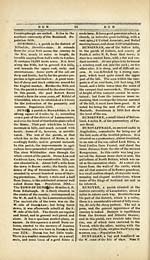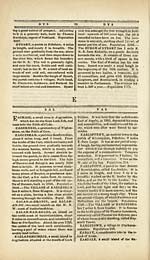Gazetteer of Scotland
(95) Page 93 - DUN
Download files
Complete book:
Individual page:
Thumbnail gallery: Grid view | List view

D U R
is a small tillage of the same name, with a
post-office.
DUNWAR, a hill in the parish ofEagle-
tham, Renfrewshire, in height 1000 feet.
DUPLIN, a parish in Perthshire, united
in 1618, to that ot'Abergaldy. (q. v.)
DURISDEEK,aparishin Dumfries-shire,
K miles long, and 5 br;>;:d. It is almost
surrounded by hills, having a pleasant o-
pening towards the S. and S. W. It is di-
vided by the river Nith ; and the Carron
also runs through it. Except the surround- |
ing hills, the general appearance of thepa-
rish is flat, and the soil tolerably fertile. It
contains 14,636 Scots acres, of which there
are about 3000 acres arable, and 11,000
pasture and plantations. The VILLAGE
of DURISDEER is pleasantly situated on
the banks ofthe Nith, over which there is
a handsome bridge of 3 arches. Several
ruins of old towers, forts, and chapels, are
to be seen here.— Population 1429.
DURNESS, a parish in the county of Su-
therland, 1£> miles in length, and 13 in
breadth. The greatest part is a peninsula,
formed by Loch Eribole and the bay of
Durness. The scenery of the parish is wild
and mountainous ; but, towards the shore,
especially where the peninsula terminates
in Far-out-head, there are several beauti-
ful fields and rich pastures. Cape Wrath
is situated at the N. W. corner of the pa-
rish ; besides which there are two other re-
markable promontories, viz. Far-out-head
and White head. Loch F.rribole is a safe
and spacious harbour. A great quantity of
kelp is burnt on the shores. There are se-
veral very remarkable caves, of which that
ofSmoorSmoah is the largest and most
magnilicent. A short way within the
mouth ofthe cave is an aperture, through
•which a stream of water descending forms
a subterraneous lake, the extent of which
has never been ascertained. In this cave
is a remarkable echo. The whole parish
rests on a bed of limestone. The river
Hope contains a few trout and salmon.
The most remarkable monument oS" anti-
quity is the famous tower, Dun Domtdilla,
situated in the valley of Strathmore, in a
remote and picturesque spot, full 7 miles
fiom the sea. It has been built, like Co-
les castle, and other edifices of the kind,
without any cement, when the use of iron
was unknown. This building is unques-
tionably the most ancient remains of anti-
quity in the island. Population 1 155.
DURRIS, a parish in Kincardineshire,
extending about 8 miles in length, and 5
and a half iu breadth, containing 16,000 '
95 D Y K
acres. It lies on the S. bank of the Dee,
from which the ground rises, and termi-
nates in the ridge ofthe Grampian moun-
tains. A great part ofthe parish has been
lately enclosed, and great improvements in
agriculture are going on. There are sever-
al high mountains, of which Caimmonearu
is the highest. Population 724.
DUTHILandROTHIEMUKCHUS.two
united parishes, situated partly in Moray
and Inverness shires, 20 miles long, and
nearly 1 7 in breadth . The general appear-
ance is hilly. The Spey runs between the
two parishes, and the river Dulnan inter-
sects Duthil for upwards of 1 5 miles. The
soil on the hanks of both rivers is fertile.
There are two small lakes in Rothiemur-
chus ; one of them, Lochnellan, has an is-
land and a ruinous castle, noted for a re-
markable echo. The military road from
Dalnacardoch to Inverness passes through
the parish. In the district of Rothiemur-
chus is a quarry, or rather mountain, of
excellent limestone, much used for ma-
nure. Population 1613.
DYCE, a parish in Aberdeenshire, of
considerable extent, lying along the side
ofthe river Don. The ridge of hills called
Tyre-beggar runs directly through the pa-
rish. On the top of one of th« highest is a
Druidical temple. The whole of the hills
are covered with heath and plantations.
The rest ofthe parish produces line crops.
Population 498.
DYKE and MOY, an united parish in
Morayshire. It runs up the Moray Frith 6
miles, stretching from the coastward near-
ly the same. Along the coast is that ex-
tensive sandy desert, called the Maviston-
sand hills, which Boethius mentions as be-
ing produced by the same inundation ofthe
sea which swept away the estate of Earl
Godwin in Kent, and leftthe Godwin sands
in its room. Above this desert lies an ex-
tensive moor. The rest of the parish is
cultivated. It contains three small villa-
ges. The river Findhorn is of considera-
ble value for its salmon fishings. The ba-
rony of Culbin, called in former times " the
Granary of Moray," has been entirely co-
vered with sand blowing from the Maviston
hills. Another effect of the blowing of the
sand is the change made about 120 years
ago in the bed and mouth of the river,
which has occasioned the removal of the
town and harbour of Findhorn at least three
quarters of a mile down the frith ; and,
where the ancient town of Findhorn stood,
nothing appears but sand and benty grass.
At Darnaway isan old castle, command-
is a small tillage of the same name, with a
post-office.
DUNWAR, a hill in the parish ofEagle-
tham, Renfrewshire, in height 1000 feet.
DUPLIN, a parish in Perthshire, united
in 1618, to that ot'Abergaldy. (q. v.)
DURISDEEK,aparishin Dumfries-shire,
K miles long, and 5 br;>;:d. It is almost
surrounded by hills, having a pleasant o-
pening towards the S. and S. W. It is di-
vided by the river Nith ; and the Carron
also runs through it. Except the surround- |
ing hills, the general appearance of thepa-
rish is flat, and the soil tolerably fertile. It
contains 14,636 Scots acres, of which there
are about 3000 acres arable, and 11,000
pasture and plantations. The VILLAGE
of DURISDEER is pleasantly situated on
the banks ofthe Nith, over which there is
a handsome bridge of 3 arches. Several
ruins of old towers, forts, and chapels, are
to be seen here.— Population 1429.
DURNESS, a parish in the county of Su-
therland, 1£> miles in length, and 13 in
breadth. The greatest part is a peninsula,
formed by Loch Eribole and the bay of
Durness. The scenery of the parish is wild
and mountainous ; but, towards the shore,
especially where the peninsula terminates
in Far-out-head, there are several beauti-
ful fields and rich pastures. Cape Wrath
is situated at the N. W. corner of the pa-
rish ; besides which there are two other re-
markable promontories, viz. Far-out-head
and White head. Loch F.rribole is a safe
and spacious harbour. A great quantity of
kelp is burnt on the shores. There are se-
veral very remarkable caves, of which that
ofSmoorSmoah is the largest and most
magnilicent. A short way within the
mouth ofthe cave is an aperture, through
•which a stream of water descending forms
a subterraneous lake, the extent of which
has never been ascertained. In this cave
is a remarkable echo. The whole parish
rests on a bed of limestone. The river
Hope contains a few trout and salmon.
The most remarkable monument oS" anti-
quity is the famous tower, Dun Domtdilla,
situated in the valley of Strathmore, in a
remote and picturesque spot, full 7 miles
fiom the sea. It has been built, like Co-
les castle, and other edifices of the kind,
without any cement, when the use of iron
was unknown. This building is unques-
tionably the most ancient remains of anti-
quity in the island. Population 1 155.
DURRIS, a parish in Kincardineshire,
extending about 8 miles in length, and 5
and a half iu breadth, containing 16,000 '
95 D Y K
acres. It lies on the S. bank of the Dee,
from which the ground rises, and termi-
nates in the ridge ofthe Grampian moun-
tains. A great part ofthe parish has been
lately enclosed, and great improvements in
agriculture are going on. There are sever-
al high mountains, of which Caimmonearu
is the highest. Population 724.
DUTHILandROTHIEMUKCHUS.two
united parishes, situated partly in Moray
and Inverness shires, 20 miles long, and
nearly 1 7 in breadth . The general appear-
ance is hilly. The Spey runs between the
two parishes, and the river Dulnan inter-
sects Duthil for upwards of 1 5 miles. The
soil on the hanks of both rivers is fertile.
There are two small lakes in Rothiemur-
chus ; one of them, Lochnellan, has an is-
land and a ruinous castle, noted for a re-
markable echo. The military road from
Dalnacardoch to Inverness passes through
the parish. In the district of Rothiemur-
chus is a quarry, or rather mountain, of
excellent limestone, much used for ma-
nure. Population 1613.
DYCE, a parish in Aberdeenshire, of
considerable extent, lying along the side
ofthe river Don. The ridge of hills called
Tyre-beggar runs directly through the pa-
rish. On the top of one of th« highest is a
Druidical temple. The whole of the hills
are covered with heath and plantations.
The rest ofthe parish produces line crops.
Population 498.
DYKE and MOY, an united parish in
Morayshire. It runs up the Moray Frith 6
miles, stretching from the coastward near-
ly the same. Along the coast is that ex-
tensive sandy desert, called the Maviston-
sand hills, which Boethius mentions as be-
ing produced by the same inundation ofthe
sea which swept away the estate of Earl
Godwin in Kent, and leftthe Godwin sands
in its room. Above this desert lies an ex-
tensive moor. The rest of the parish is
cultivated. It contains three small villa-
ges. The river Findhorn is of considera-
ble value for its salmon fishings. The ba-
rony of Culbin, called in former times " the
Granary of Moray," has been entirely co-
vered with sand blowing from the Maviston
hills. Another effect of the blowing of the
sand is the change made about 120 years
ago in the bed and mouth of the river,
which has occasioned the removal of the
town and harbour of Findhorn at least three
quarters of a mile down the frith ; and,
where the ancient town of Findhorn stood,
nothing appears but sand and benty grass.
At Darnaway isan old castle, command-
Set display mode to: Large image | Transcription
Images and transcriptions on this page, including medium image downloads, may be used under the Creative Commons Attribution 4.0 International Licence unless otherwise stated. ![]()
| Gazetteers of Scotland, 1803-1901 > Gazetteer of Scotland > (95) Page 93 - DUN |
|---|
| Permanent URL | https://digital.nls.uk/97422834 |
|---|

